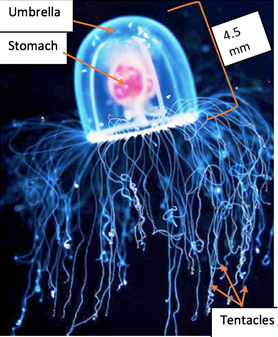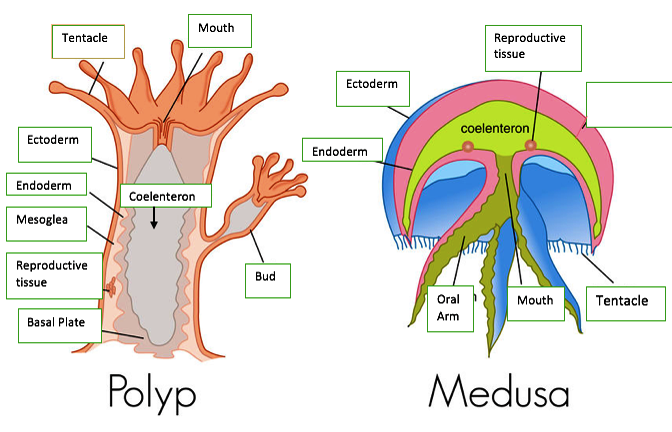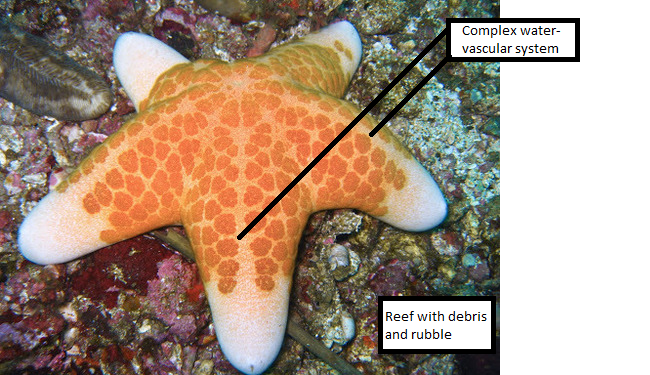DOMAIN • THREE
• Eukarya•
There are four subdivisions in domain Eukarya. These subdivisions are known as kingdoms and are the following:
Common name- Immortal Jellyfish
Domain- Eukarya
Kingdom- Animalia
Phylum- Cnidaria
Class- Hyrdozoa
Order- Anthoathecata
Family- Oceaniidea
Genus- Turritopsis
Species- dohrnii

Figure 4a: The Immortal Jellyfish
In the image above one can see the appearance and size of the Immortal Jellyfish during the medusa stage

Figure 5a: Jellyfish Stages
In the image above one can see the two different stages of a jellyfish. One can see the polyp stage and the medusa stage. One can also see a bud forming on a polyp.
The Turritopsis dohrnii is a motile jellyfish found in salt waters such as the West Atlantic, Eastern Ligurian Riviera and many shallow waters in tropical environments with moderate temperatures [13a]. This jellyfish, also known as the Immortal Jellyfish, feeds off of tiny brine shrimp. By using their cnidocytes, they can paralyze an organism and then eat it [14a]. The Immortal Jellyfish starts off as an egg, then becomes a larva which develops into a polyp. The polyp phase is a phase in which the organism will be non-motile, it will be stuck at the bottom of the ocean feeding off things that are near. Buds will eventually form on one side of the polyp, and then will soon develop into a mouth. Eventually the bud will leave the polyp and become its own polyp. This is asexual reproduction.
After this stage, the newly developed polyp will develop into a jellyfish. This stage is known as the medusa stage. During this stage the jellyfish will be motile, they will move by swaying their tentacles. The Turritopsis dohrnii was given its more common name, the Immortal Jellyfish, because this jellyfish has the potential to live forever. Their cells can go through a process known as transdifferentiation. During this process, their cells will return to a mucous membrane, their tentacles will go inside their body, they will shrink and go to the bottom of the ocean returning to the polyp stage once again. Due to the presence of nervous system, they can sense danger. When they sense danger, they go through this cycle for self preservation. This can be a never ending cycle; the only exception is if the jellyfish is consumed by a predator.
The Immortal Jellyfish is extremely small and hard to see with the naked eye. It is approximately 4.5 mm wide, which is smaller than a pinky nail. This organism also has a transparent umbrella, a bright red stomach, and a nervous system [12a].
Why this belongs in this Domain:
This organism has eukaryotic cells, making it part of domain Eukarya. It is also an animal, placing it in the kingdom Animalia. Due to the fact that this organism is a jellyfish and lives in water, it is under the phylum Cnidaria. It is under the class Hydrozoa due to the fact that it lives in salt water, it is very small and can be considered a predator. Due to the absence of the vertebral column, the organism is in the order known as Anthoathecata. This organism does not belong in the domains Archaea and Bacteria. This is mainly because the Immortal Jellyfish does not have prokaryotic cells. A reason that it cannot be in domain Archaea is because this organism is multicellular and heterotrophic, unlike the organisms in Archaea which are autotrophic and unicellular. A reason that it cannot be in domain Bacteria is because it is not unicellular, and isnot motile through a source of flagellum, cilia, or type IV pili.
Common name- Granulated Starfish
Domain: Eukarya
Kingdom: Animalia
Phylum: Echinodermata
Class: Asteroidea
Order: Valvatida
Family: Oreasteridae
Genus: Choriaster
Species: granulatus

Figure 10b: Granulated Starfish
This image shows the star fish living on the reef in the ocean
The Granulated Starfish is a multicellular, eukaryotic, organism that can usually be found living on reefs in the ocean. These reefs contain a lot of debris and rubble, which is convenient for the organisms because they eat debris. Their diet includes worms, debris, and mollusks. Although their mouths are underneath them, they are still able to maintain a healthy lifestyle by other methods of ingestion. One method of ingestion is that the starfish pushes out its digestive organs from its stomach and absorbs the food. Most of these color-varying starfish can be found in the Indo-Pacific region. Granulated Starfish measure 25 cm in length. These starfish have the ability to regenerate any of their five short, cone shaped, and thick arms. Because of attackers and predators, an arm of a starfish could be cut off or damaged. This could result in the starfish having only four arms for a period of time. Their ability to move,grab and hold onto things and organisms in the ocean is due to their hydraulic tube feet. The hydraulic tube feet are connected to a complex water-vascular system that starts at the mouth and extends down each of the five arms. It has a nervous system and it reproduces sexually by releasing sperm and eggs into surrounding water. The egg will then become fertilized and will become part of a zooplankton, a free floating protozoa. It reproduces asexually by a process known as fragmentation. Part of the central disk and arm will be disconnected from the adult starfish and will then develop on its own to become anadult starfish. [14b].
Why this belongs in this Domain:
Although many people believe starfish are not alive, this is a misconception. The Granulated Starfish belongs to the domain Eukarya because it has eukaryotic cells and it belongs to the kingdom Animalia because it is an animal. It belongs in the phylum Echinodermata because it is symmetrical and contains 5 points. Also, it belongs in this phylum because it lives in sea water, not fresh water. Since this starfish has tube feet, it belongs to the order Valvatida. The yellow-orange color allows this animal to be classified into the family Oreasteridae which contains brightly colored starfish. It does not belong in domain Bacteria and domain Archaea because it does not have prokaryotic cells, and because it is not unicelluar.In addition, it has a stomach which no other organisms in the other two domains have.
DM/RJ